WFANet-DDCL:基于小波频率注意网络和对偶域一致性学习的7T MRI与3T MRI合成
IF 11.1
1区 工程技术
Q1 ENGINEERING, ELECTRICAL & ELECTRONIC
IEEE Transactions on Circuits and Systems for Video Technology
Pub Date : 2025-01-30
DOI:10.1109/TCSVT.2025.3536807
引用次数: 0
摘要
超高场磁共振成像(MRI),如7-特斯拉(7T) MRI,与3T MRI相比,提供了显著增强的组织对比度和解剖细节。然而,与3T扫描仪相比,7T MRI扫描仪在临床环境中更昂贵,更不易获得。本文提出了一种基于小波的频率注意网络(WFANet)和一种名为对偶域一致性学习(dual domain consistency learning, DDCL)的半监督方法,并将它们结合起来形成用于7T MRI合成的WFANet-DDCL框架。WFANet利用了所提出的基于小波的频率注意编码器(WFAE)的频率灵敏度以及扩展卷积的大接受场。采用基于小波的频率注意(WFA)机制,将WFAE作为一个独立的模块来捕获多尺度频率注意。WFAE可以作为即插即用组件集成到任何骨干网中,提高网络性能。为了解决网络训练中配对数据有限的问题,DDCL提出了同时利用成对数据和未成对数据的方法。提出了频域扰动,并结合高斯噪声对双域监督学习过程进行正则化,更好地避免了过拟合。大量的实验结果表明,即使使用66%的成对数据,WFANet-DDCL也可以达到与最先进的监督方法相当的性能。本文章由计算机程序翻译,如有差异,请以英文原文为准。
WFANet-DDCL: Wavelet-Based Frequency Attention Network and Dual Domain Consistency Learning for 7T MRI Synthesis From 3T MRI
Ultra-high field magnetic resonance imaging (MRI), such as 7-Tesla (7T) MRI, provides significantly enhanced tissue contrast and anatomical details compared to 3T MRI. However, 7T MRI scanners are more costly and less accessible in clinical settings than 3T scanners. In this paper, we propose a wavelet-based frequency attention network (WFANet) and a semi-supervised method named dual domain consistency learning (DDCL), and combine them to form a WFANet-DDCL framework for 7T MRI synthesis. WFANet leverages the frequency sensitivity of the proposed wavelet-based frequency attention encoder (WFAE) along with the large receptive field of dilated convolution. WFAE is proposed as an independent module to capture multi-scale frequency attention via the proposed wavelet-based frequency attention (WFA) mechanism. WFAE can be integrated into any backbone network as a plug-and-play component and improve network performance. To tackle the challenge of limited paired data for network training, DDCL is proposed to take advantage of both paired and unpaired data. Frequency domain perturbation is proposed and combined with Gaussian noise to regularize the supervised learning process in dual domains, better avoiding overfitting. Extensive experimental results demonstrate that WFANet-DDCL can achieve comparable performance to state-of-the-art supervised methods even using 66% of all paired data.
求助全文
通过发布文献求助,成功后即可免费获取论文全文。
去求助
来源期刊
CiteScore
13.80
自引率
27.40%
发文量
660
审稿时长
5 months
期刊介绍:
The IEEE Transactions on Circuits and Systems for Video Technology (TCSVT) is dedicated to covering all aspects of video technologies from a circuits and systems perspective. We encourage submissions of general, theoretical, and application-oriented papers related to image and video acquisition, representation, presentation, and display. Additionally, we welcome contributions in areas such as processing, filtering, and transforms; analysis and synthesis; learning and understanding; compression, transmission, communication, and networking; as well as storage, retrieval, indexing, and search. Furthermore, papers focusing on hardware and software design and implementation are highly valued. Join us in advancing the field of video technology through innovative research and insights.

 求助内容:
求助内容: 应助结果提醒方式:
应助结果提醒方式:


